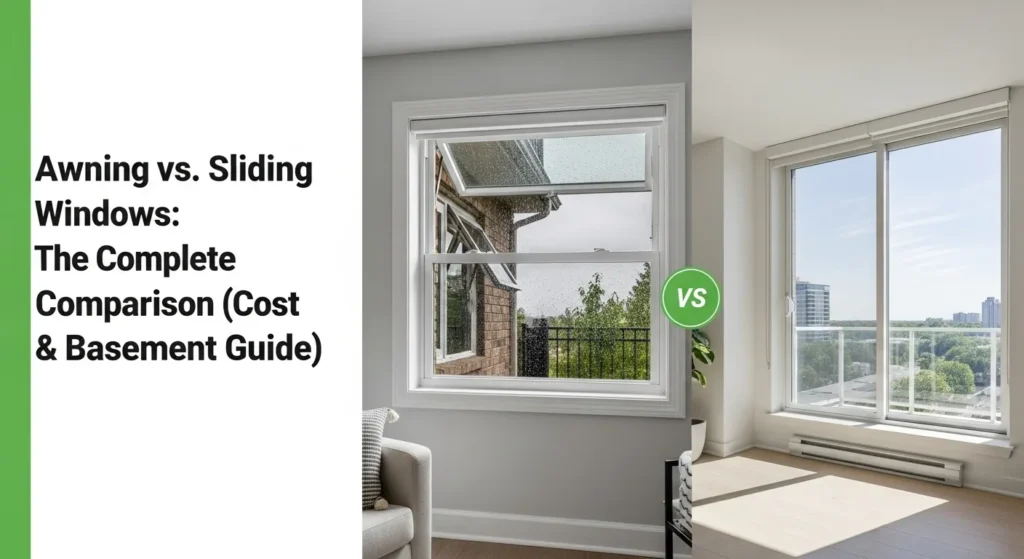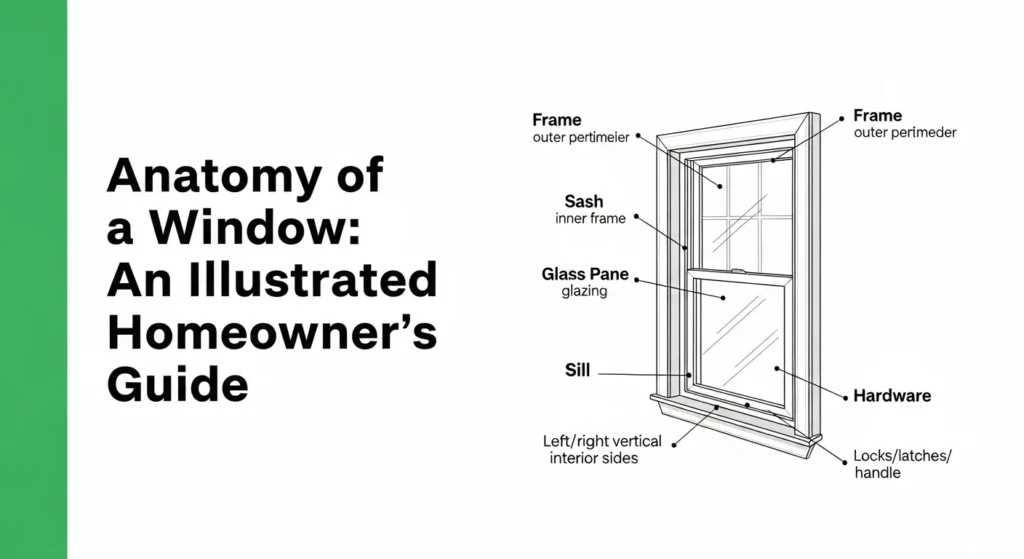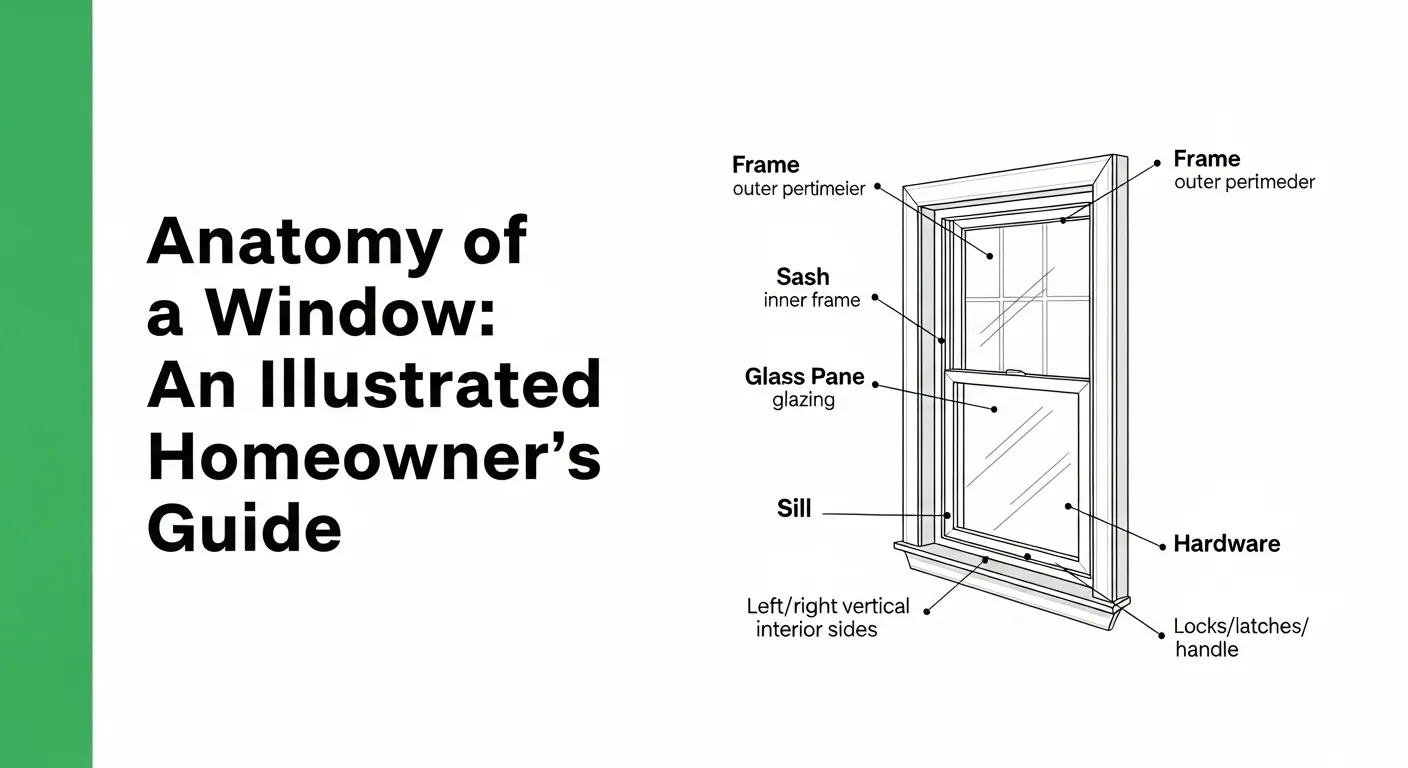Seeing a puddle on your windowsill during a rainstorm is a homeowner’s nightmare.
Most “leaks” trace back to a few fixable culprits—clogged weep holes, failed exterior caulk, or degraded glazing—not necessarily a defective window. Acting quickly prevents hidden water damage and mold. This guide walks you through a clear “find, then fix” process to diagnose the true source and apply the right repair safely.
Related help:
- Unsure if it’s a frame crack? See How to Repair a Cracked Vinyl Window Frame.
- If the glass unit itself is foggy or has failed, read How to Replace the Glass in a Vinyl Window.
Is It a Leak or Just Condensation?
Condensation is indoor humidity collecting on a cold surface; a leak is exterior water entering the assembly. Confirm this first to avoid chasing the wrong problem.

- Here is a checklist for identifying likely condensation:
- Widespread moisture on glass, not isolated to one spot.
- Appears on cold, humid days or after showers/cooking.
- No water trail from frame joints or drywall transitions.
- Dries when humidity drops or with ventilation/dehumidification.
- Leak clues (likely leak if you notice):
- Drips or trails originating at corners, frame joints, or head/jamb.
- Wet sill only during rain or wind-driven rain.
- Stains above the window or damp drywall/trim.

Finding the Leak’s Source (The Diagnostic Phase)
Start with a visual inspection of the three most common points of failure, then confirm with a controlled water test.
The Visual Inspection: What 3 Hotspots Should You Check First?
- Clogged weep holes (bottom exterior frame)
- Purpose: Drain water that enters the frame chamber to the outside.
- Sign: Puddling in the sill, slow drainage, dirt/spider webs at weeps.
- Cracked or peeling exterior caulk (perimeter seal)
- Focus: Where the window frame meets siding/stucco/brick.
- Sign: Gaps, splits, detached beads, hardened/brittle caulk.
- Failed glazing seal (glass-to-sash interface)
- Focus: The seam where glass meets the vinyl sash—often under a glazing bead.
- Sign: Visible gaps, missing bead, brittle sealant; localized leak at glass edge.

The Water Test: How Do You Pinpoint the Exact Leak Location?
Use a low-pressure hose and a helper. Wet one section at a time for 2–3 minutes; the first drip you see inside reveals the source.
- Tools: Garden hose with spray nozzle (shower pattern), helper inside with flashlight and towel.
- Test order (bottom to top):
- Sill and weep holes
- Vertical frame sides (jambs)
- Top of frame (head)
- The glass itself (edges, not directly at weep holes)
- Instructions:
- Keep the nozzle at least 12–18 in away; avoid high pressure.
- Spray each area for 2–3 minutes before moving on.
- The helper should call out immediately at first sign of a drip; note exactly where you’re spraying at that moment.

The Critical Question: Is the Leak in the Window or the Wall?
Water can enter above the window (behind siding/flashings) and appear at the window. Use an isolation test to separate wall leaks from window leaks.
- The Isolation Test (simple exterior seal-off)
- Dry the exterior frame.
- Use painter’s tape and plastic sheeting to fully cover and seal the entire window unit (frame and glass), leaving surrounding wall exposed.
- Spray the wall above and around the sealed window for 3–5 minutes.
- Observe inside:
- If it still leaks: The wall, siding, or head flashing is the culprit → call a pro.
- If it doesn’t leak: The problem is within the window unit → proceed to Step 4.

Applying the Right Fix Based on Your Diagnosis
Fixes must match the failure. Clear drainage, restore perimeter sealant, or re-glaze the glass-to-sash interface. Do not seal over drainage pathways.
If the Leak Is From Weep Holes… (The Easy Fix)
Clear obstructions so the frame drains as designed.
- Steps:
- Insert a paperclip or plastic pick into each exterior weep to dislodge debris.
- Blow out with compressed air or gently flush with water.
- Verify water exits freely during a quick retest.
- Tips:
- Do not enlarge weep holes.
- Clean weeps every spring/fall as routine maintenance.
If the Leak Is Around the Exterior Frame… (The Caulk Fix)
Remove failed caulk and apply a continuous, flexible, exterior-grade bead—leaving intended drainage paths open.
- Tools/Materials:
- Utility knife/oscillating tool with scraper, plastic putty knife
- Isopropyl alcohol or manufacturer-recommended cleaner
- Backer rod for gaps > 1/4 in
- Sealant: ASTM C920 Class 25 elastomeric or 100% neutral-cure silicone rated for exterior/vinyl
- Caulk gun, soapy water + rag for tooling
- Steps:
- Cut out old caulk completely and clean residue.
- Wipe surfaces with isopropyl; let dry.
- Insert backer rod where needed for correct joint depth.
- Apply a steady bead along the sides and head; avoid sealing weep holes or trapping water.
- Tool the bead smooth; follow cure times (often 24 hours; check label).
- Expert Tip: Look for “vinyl-safe,” “UV resistant,” and “wet weather” or “rain-ready” formulations if storms are imminent.
- For new installations and best practices that prevent leaks: How to Properly Shim, Seal, and Insulate a New Vinyl Window
- Installation: How to Install a Vinyl Window Without a Nailing Flange
If the Leak Is Between the Glass and Frame… (The Glazing Fix)
Restore the glass-to-sash seal with glazing sealant and properly seated glazing beads.
- Steps:
- Identify the removable glazing bead/stops; carefully pry off with a plastic tool.
- Clean the glass edge and sash channel; remove brittle sealant.
- Apply a thin, continuous bead of neutral-cure silicone compatible with insulated glass.
- Reseat the glazing bead evenly; wipe any squeeze-out.
- Allow full cure before water testing.
- Note: If you see moisture between panes, the insulated glass unit (IGU) edge seal has failed—resealing the sash interface won’t correct it. See How to Replace the Glass in a Vinyl Window.
When to Call a Professional Window Contractor
Call a pro for wall/flashing failures, structural issues, or glass/IGU replacement.
- Red flags checklist:
- Isolation Test shows wall or flashing leak (not the window).
- Water stains on wall/ceiling above the window.
- Cracked/warped frame or soft/rotting wood in sill/framing.
- Foggy glass or moisture between panes (failed IGU).
- Repeated leaks after proper caulking and weep maintenance.
- Next step: Seek licensed, insured contractors; get 3 written estimates and confirm warranty terms. If a replacement is on the table, review Do Vinyl Windows Increase Home Value? and The Average Cost to Install Vinyl Windows.
Bonus: Emergency Storm Prep & Long‑Term Prevention
Quick Temporary Fix During a Storm
Control and divert water inside until you can perform a permanent repair.
- Tape plastic sheeting over the interior of the window opening.
- Place towels and a shallow pan at the sill.
- If water is near outlets, switch off the circuit and avoid the area.
- After the storm, dry thoroughly and proceed with diagnosis/repair.
Annual Maintenance Checklist
Simple seasonal tasks prevent most leaks.
- Inspect exterior caulk every spring/fall; reseal gaps early.
- Clean weep holes and ensure free drainage.
- Check and replace weatherstripping if compressed or cracked.
- Keep gutters and head flashings clear; avoid pressure washing windows.
- For sticky sashes, use a 100% silicone spray—not oil-based products. See Can You Use Windex or WD‑40 on Vinyl Windows?
- If operation is an issue, see How to Fix a Vinyl Window That Won’t Stay Up.
Frequently Asked Questions (FAQs)
Should I seal weep holes to stop water coming in?
What sealant is best for vinyl window perimeters?
Can pressure washing cause window leaks?
How long must caulk cure before rain?
Custom vinyl windows, tailored to your home. Boost comfort and curb appeal with the sizes, colors, and glass you choose.
Customize Now









